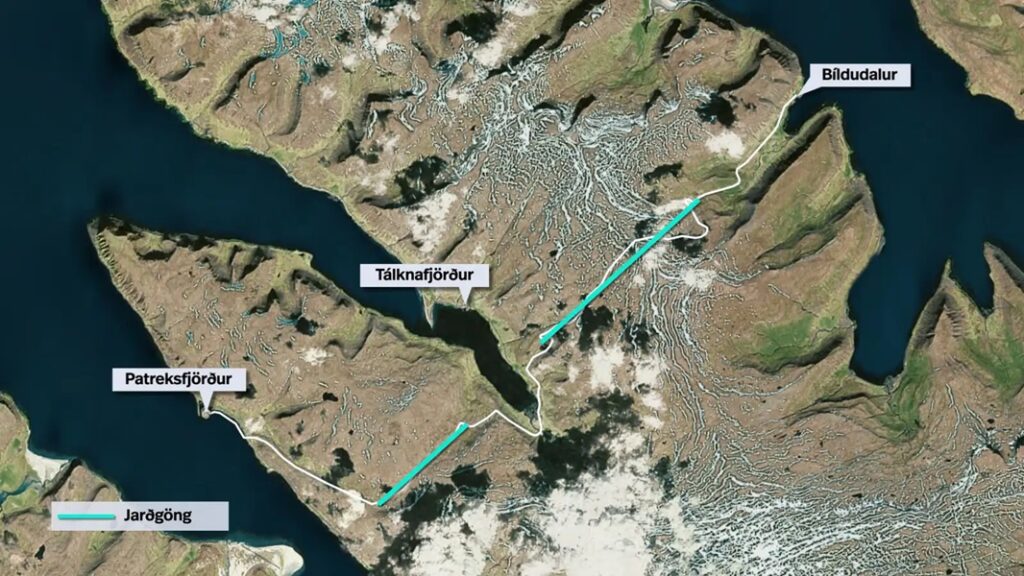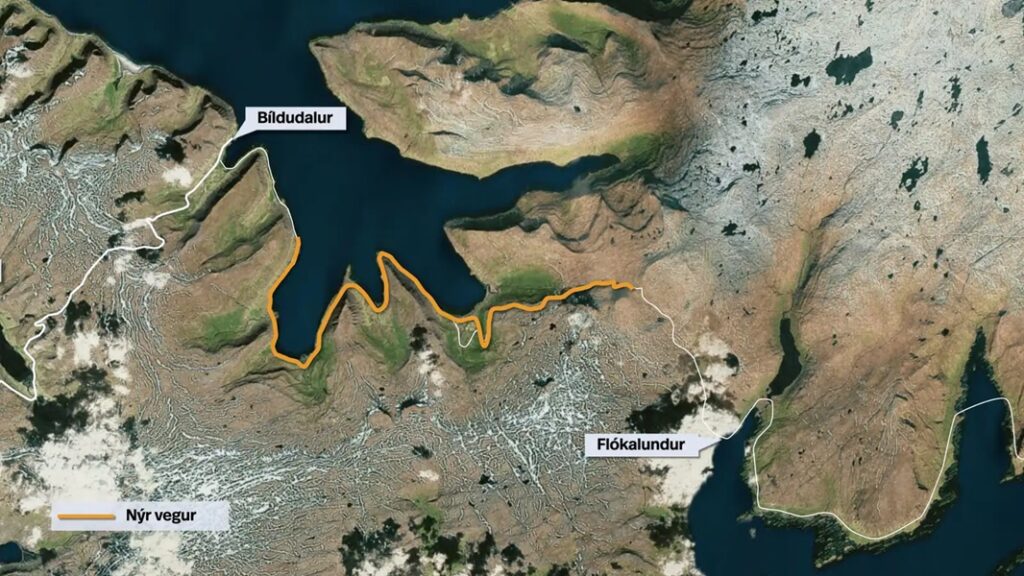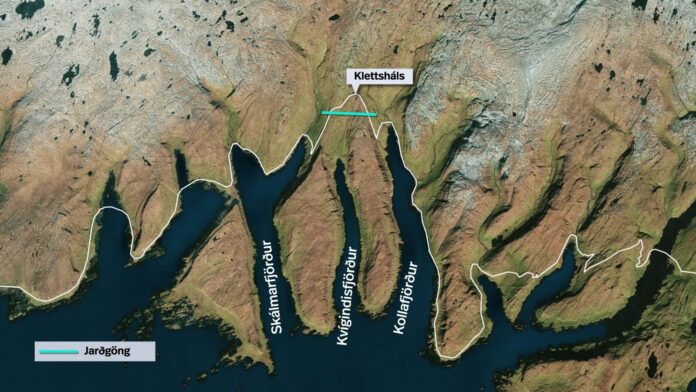Municipalities in the Westfjords are emphasising the development of transport infrastructure. Analysts at VSÓ Ráðgjöf (an Icelandic consultancy firm) are now attempting to prioritise projects for an implementation plan.
A tunnel under Klettsháls could be the best tunnel option in the Westfjords, according to analysis work for a new regional plan in the area by VSÓ Ráðgjöf (an Icelandic consultancy firm), and the most important road improvement would be on the road from Bíldudalur into Arnarfjörður.
A closer look at the data, however, quickly shows that preparatory work and studies are still lacking before any decisive decisions can be made.
Since the Dýrafjörður tunnel opened in 2019, no tunnel construction has taken place. The government has promised to break the standstill in tunnel building. However, it may still be a long time until the next tunnel in the Westfjords.
The municipalities in the Westfjords are, for the first time, working on a joint regional plan. One of its main pillars is an infrastructure plan, which is to outline what can be expected in terms of infrastructure projects during its validity.
At a regional meeting held in Hnífsdalur, Smári Ólafsson at VSÓ presented ongoing analysis of which transport projects are most pressing.
An attempt is being made to apply an objective assessment of projects. The possible benefits are measured according to several factors:
- Time saved in traffic
- Safety
- Cost
- Social impact
- Connection between settlements
- Connection between regions
- Impact on Vestfjarðaleiðin, the Westfjords ring road
At the next stages of work it will have to be assessed which factors should be given the most weight. Although the work is not yet complete, the presentation sparked strong reactions from municipal representatives.
Klettsháls is in the southern Westfjords. A tunnel beneath it would shorten the distance between the Westfjords and other parts of the country and make it safer.
This is the road that closes most often in winter and would also be a relatively inexpensive project compared with other planned tunnels. It therefore ranked highest based on the available data.
In the current prioritisation of Vegagerðin (Icelandic Road and Coastal Administration), however, it is in ninth place out of ten, and municipal councils in the Westfjords have placed much more emphasis on other options.
The next option in line would be the Álftafjörður tunnel, which is to connect Súðavík and Ísafjörður. In the current prioritisation, it is number five nationally and the first to be undertaken in the Westfjords. After that comes the building of a second parallel tunnel of the Vestfirðir tunnel, which connects Suðureyri and Flateyri to Ísafjörður.

Fréttagrafík / Kristrún Eyjólfsdóttir
Representatives of Vesturbyggð, the largest municipality in the southern Westfjords, pointed out that the results are unreliable because the calculations are based on incorrect assumptions, at least as far as the southern fjords tunnel is concerned. This refers to two tunnels that would connect the main settlements of Vesturbyggð – Patreksfjörður, Tálknafjörður and Bíldudalur.
Gerður Björk Sveinsdóttir, municipal manager of Vesturbyggð, says,
The root of the problem perhaps lies in the fact that there has not been proper work done on tunnel routes, and the assumptions of this report are based on lines drawn on paper in the past by Vegagerðin, and all the work basically stems from that.
The infrastructure committee of the Westfjords regional association has not finished its work, but Gerður would have liked the municipalities to have been involved earlier. They placed much more emphasis on improved transport between settlements than on connections between regions.
The alignment of the tunnels could, for example, greatly affect how their impact is assessed.
This is basically based on the assumption that the tunnel entrance is very high up, at about 270 metres above sea level, and therefore the social benefits of tunnel construction are considered low… [but of] Those who have lived with isolation due to difficult mountain roads, and then get tunnels; I think everyone agrees that this has had significant positive social effects.
She points out that this criticism highlights once again that the Westfjords are lagging behind in tunnel preparations.
It perhaps also just shows us how important it really is to put money into studies and proper data collection on these options.
Gerður also notes that the assessment does not take into account how urgent the need is for tunnels between Patreksfjörður and Tálknafjörður, where the mountain road currently linking the settlements is in very poor condition.
It does not stand up to scrutiny. I understand that no maintenance work has been carried out on it this summer since the base [of the road surface] is basically ruined and it is of no use.
The presentation emphasised that more is needed to improve transport in the Westfjords than tunnels, which are expensive and take a long time to complete.
Fifteen major road projects were assessed on the same basis as the tunnel options. Planned road improvements on the route from Bíldudalur into Arnarfjörður up to the Dýrafjörður tunnel scored significantly highest.
Next came the road out to Látrabjarg and a bridge over Vatnsfjörður. These would be improvements that would yield benefits much sooner than tunnels.

Ongoing road improvements by Vegagerðin in the southern Westfjords are a good example. Once completed, the southern route between the Westfjords and Reykjavík will be half an hour shorter. Single-lane bridges will be fewer, the route straighter, and difficult mountain passes like Ódrjúgsháls will be gone. These projects, however, have been on Vegagerðin’s agenda for decades and are still unfinished.
Finally, the analysts reiterated the importance of making better use of the roads already in place. With improved maintenance and increased winter service, the situation would immediately improve. Gerður agrees and says it is clear that Westfjords residents receive some of the worst winter service in the country.
It is simply the case that the roads here between the settlements are not ploughed after eight in the evening. However, people are working and coming home from work after that. We are struggling to coordinate services for young people because of this, essentially [we get] just the service hours of Vegagerðin. So it is absolutely time this was reviewed.
Source: Ruv.is




